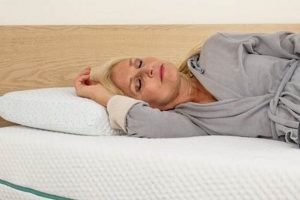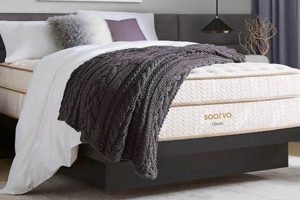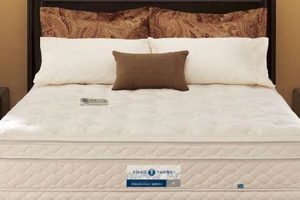The practice involves placing a bed’s core component directly upon the ground, foregoing the traditional support structure of a bed frame or box spring. This setup presents a minimalist approach to bedroom furnishing, focusing on simplicity and space utilization.
This arrangement offers potential advantages such as cost savings, reduced profile in smaller spaces, and a perceived increase in room volume. Historically, ground-level sleeping has been a common practice in various cultures, reflecting diverse needs and living conditions. Some proponents claim improved spinal alignment and easier access for individuals with mobility limitations.
The subsequent sections will delve into the implications of this configuration, covering considerations for hygiene, comfort, and potential health effects. This exploration aims to provide a balanced perspective on the suitability of this sleeping arrangement for different individuals and living environments.
Tips for Ground-Level Mattress Placement
Implementing a sleeping arrangement directly on the floor necessitates careful consideration to mitigate potential drawbacks and maximize benefits.
Tip 1: Prioritize Ventilation: Adequate airflow beneath the mattress is crucial to prevent moisture accumulation and mold growth. Regularly elevate the mattress, at least weekly, to allow thorough ventilation. Consider using a breathable underlayment, such as a slatted platform or a moisture-wicking mat, to enhance air circulation.
Tip 2: Maintain Cleanliness: Regular vacuuming of the floor surface where the mattress rests is essential to minimize dust mites and allergens. Wash bedding frequently in hot water to eliminate potential irritants. Implement a strict no-food-or-drink policy in the sleeping area to prevent spills and pest infestations.
Tip 3: Select the Appropriate Mattress Type: Not all mattresses are suitable for floor placement. Foam mattresses, particularly memory foam, may trap moisture and lack adequate support without a foundation. Innerspring mattresses may be more durable and offer better ventilation. Research mattress construction and suitability for ground-level use before purchase.
Tip 4: Consider Physical Limitations: Individuals with mobility issues or back pain may find getting into and out of a floor-level sleeping arrangement challenging. Evaluate physical capabilities and consult with a healthcare professional to determine if this setup is appropriate.
Tip 5: Monitor for Signs of Moisture or Mold: Regularly inspect the mattress and surrounding floor area for signs of dampness, discoloration, or musty odors. Address any issues promptly to prevent mold growth and potential health problems. Use a dehumidifier in humid environments to control moisture levels.
Tip 6: Choose the Right Flooring: Certain flooring types are more conducive to floor-level mattress placement. Hardwood or tile floors are generally preferable to carpet, as they are easier to clean and less prone to trapping moisture. If carpet is unavoidable, ensure it is professionally cleaned regularly and consider using a moisture barrier beneath the mattress.
Proper ventilation, consistent cleaning, and careful mattress selection are critical components of a successful and hygienic floor-level sleeping arrangement. These measures can contribute to improved comfort and reduced risks associated with this alternative sleeping style.
The following sections will explore specific health considerations and potential modifications for enhancing the comfort and functionality of this setup.
1. Ventilation Importance
Adequate ventilation is paramount when a mattress is placed directly on the floor. The absence of a bed frame restricts airflow beneath the mattress, creating an environment conducive to moisture accumulation and the subsequent proliferation of mold and mildew. Proper ventilation mitigates these risks and contributes to a healthier sleep environment.
- Moisture Accumulation Prevention
Without sufficient airflow, perspiration and ambient humidity become trapped between the mattress and the floor. This trapped moisture provides a breeding ground for mold spores, potentially leading to respiratory issues and allergic reactions. Ventilation helps dissipate this moisture, keeping the mattress dry and reducing the risk of microbial growth.
- Mold and Mildew Inhibition
Mold and mildew thrive in dark, damp environments. A mattress resting directly on the floor, especially in humid climates, is highly susceptible to these issues. Regular ventilation, achieved by elevating the mattress periodically or using a breathable underlayment, inhibits mold and mildew growth, maintaining a cleaner and healthier sleeping surface.
- Mattress Longevity Enhancement
Prolonged exposure to moisture can degrade mattress materials, shortening its lifespan. Foam mattresses, in particular, are prone to absorbing and retaining moisture, leading to structural damage and reduced support. Proper ventilation helps maintain the integrity of the mattress components, extending its usability and preventing premature deterioration.
- Indoor Air Quality Improvement
Mold and mildew release spores into the air, negatively impacting indoor air quality. These airborne contaminants can trigger respiratory problems, allergies, and other health issues. By promoting adequate ventilation, the risks associated with mold and mildew are minimized, contributing to a healthier and more comfortable indoor environment.
The principles of ventilation are essential when sleeping on mattress on the floor, impacting not only the comfort of the sleep experience but also the health and longevity of the mattress itself. Failing to address this critical aspect can lead to avoidable health risks and a reduced lifespan of the sleep surface.
2. Hygiene Maintenance
Maintaining a rigorous hygiene protocol is critically important when a mattress is placed directly on the floor. The absence of a raised bed frame increases the mattress’s exposure to dust, allergens, and potential contaminants from the floor surface. Neglecting proper hygiene can lead to a compromised sleep environment and potential health risks.
- Regular Vacuuming of the Floor Surface
The floor beneath and around the mattress accumulates dust mites, pet dander, and other allergens. Frequent vacuuming, ideally with a HEPA filter vacuum cleaner, is essential to remove these contaminants and prevent them from becoming airborne or embedded in the mattress fibers. Neglecting this practice can exacerbate allergies and respiratory issues.
- Frequent Bedding Laundering
Bed sheets, pillowcases, and mattress protectors should be laundered frequently in hot water to eliminate dust mites and other allergens. Perspiration, skin cells, and body oils accumulate in bedding, providing a breeding ground for bacteria and creating unpleasant odors. Regular laundering maintains a clean and hygienic sleep surface.
- Mattress Protection with a Waterproof Cover
A waterproof mattress cover protects the mattress from spills, stains, and bodily fluids. This barrier prevents moisture from penetrating the mattress, inhibiting mold growth and extending its lifespan. The cover should be cleaned regularly according to the manufacturer’s instructions.
- Periodic Mattress Cleaning and Deodorizing
Even with regular vacuuming and the use of a mattress protector, periodic deep cleaning may be necessary. Stains and odors can develop over time, requiring spot cleaning or professional mattress cleaning services. Deodorizing agents can also be used to freshen the mattress and eliminate unpleasant smells.
The connection between meticulous hygiene practices and ground-level sleeping arrangements cannot be overstated. Consistent and diligent hygiene maintenance is paramount to mitigating the inherent risks associated with direct floor contact, thereby ensuring a healthier and more comfortable sleep experience. The absence of a bed frame necessitates an elevated focus on cleanliness to safeguard well-being.
3. Mattress Suitability
The selection of an appropriate mattress is paramount when implementing a floor-level sleeping arrangement. The direct contact with the floor surface necessitates careful consideration of mattress type, construction, and support characteristics. Failure to select a suitable mattress can result in discomfort, compromised spinal alignment, and potential hygiene issues. For instance, a low-density foam mattress may lack sufficient support when placed directly on the floor, leading to back pain and poor sleep quality. Conversely, a robust innerspring mattress may provide adequate support but may be more susceptible to moisture accumulation due to reduced airflow. Therefore, mattress suitability is not merely a preference but a critical component of a healthy and sustainable floor-sleeping configuration.
Consider the example of individuals transitioning from a traditional bed frame to a floor-level setup. A mattress designed for use with a box spring often lacks the structural integrity required for direct floor placement. Without the box spring’s support, the mattress may sag prematurely, leading to uneven weight distribution and discomfort. In such cases, selecting a mattress specifically designed for floor use, such as a firm memory foam mattress with a breathable base, becomes essential. Similarly, individuals with allergies should prioritize mattresses constructed with hypoallergenic materials and antimicrobial treatments to minimize exposure to dust mites and other allergens that may accumulate on the floor.
In conclusion, mattress suitability is a pivotal factor influencing the success and long-term viability of a floor-level sleeping arrangement. Selecting a mattress that provides adequate support, promotes airflow, and minimizes allergen exposure is crucial for ensuring comfort, maintaining hygiene, and preventing potential health issues. This consideration extends beyond mere personal preference, representing a fundamental aspect of responsible and informed decision-making when adopting this alternative sleeping style.
4. Floor Cleanliness
Floor cleanliness is of paramount importance when a mattress is placed directly on the floor, impacting hygiene, allergen levels, and overall sleep quality. The proximity of the sleeping surface to the floor necessitates a heightened awareness of potential contaminants and the implementation of rigorous cleaning protocols.
- Dust and Allergen Accumulation
Floors accumulate dust mites, pet dander, pollen, and other allergens, which can readily transfer to a mattress in direct contact. Regular cleaning, including vacuuming and mopping, is crucial to minimize allergen levels and prevent respiratory irritation. Neglecting floor cleanliness can exacerbate allergies and compromise indoor air quality.
- Mold and Mildew Prevention
Moisture can accumulate on the floor beneath a mattress, creating an environment conducive to mold and mildew growth. Dampness from spills, condensation, or inadequate ventilation can promote microbial growth, leading to unpleasant odors and potential health risks. Routine cleaning and drying of the floor surface are essential to inhibit mold and mildew development.
- Pest Control
Unclean floors can attract pests such as ants, cockroaches, and rodents, which may infest the mattress and surrounding areas. Food debris and crumbs provide a food source for these pests, while cracks and crevices offer harborage. Regular cleaning and sealing of entry points are necessary to prevent pest infestations and maintain a hygienic sleep environment.
- Surface Integrity and Wear
Dirt and debris can abrade the mattress cover and floor surface over time, leading to premature wear and tear. Sharp objects and abrasive particles can scratch or damage the floor, while accumulated dirt can stain and discolor the mattress fabric. Regular cleaning helps maintain the integrity of both the mattress and the floor, extending their lifespan.
The connection between floor cleanliness and sleeping directly on a mattress is undeniable. Maintaining a clean and hygienic floor surface is not merely a matter of aesthetics but a fundamental requirement for ensuring a healthy and comfortable sleep environment. Prioritizing floor cleanliness mitigates potential health risks, prevents pest infestations, and prolongs the lifespan of both the mattress and the flooring material. Failure to address floor cleanliness can undermine the benefits of floor-level sleeping and compromise overall well-being.
5. Mold Prevention
Mold prevention is a critical consideration when a mattress is placed directly on the floor. The absence of a bed frame creates conditions that can promote mold growth, necessitating proactive measures to mitigate this risk. The following points outline essential strategies for preventing mold when utilizing this sleeping arrangement.
- Moisture Control
Controlling moisture levels is paramount. Mattresses resting on the floor are susceptible to moisture accumulation from perspiration, condensation, and spills. Utilizing a dehumidifier in humid environments and ensuring adequate ventilation are essential. Addressing any leaks or water damage promptly is also crucial to prevent mold formation. Ignoring moisture control can lead to widespread mold growth within the mattress and surrounding floor area.
- Air Circulation Enhancement
Promoting airflow beneath the mattress helps prevent moisture buildup. Regularly elevating the mattress, even for a short period, allows air to circulate and dry out any accumulated moisture. Using a slatted platform or a breathable underlayment can also enhance air circulation and reduce the risk of mold growth. Insufficient airflow creates a stagnant environment conducive to mold proliferation.
- Regular Cleaning Practices
Regular cleaning of the floor and mattress is essential for removing mold spores and potential food sources. Vacuuming the floor frequently and spot-cleaning any spills promptly can prevent mold from establishing itself. Using a mattress protector can also help prevent moisture and contaminants from penetrating the mattress. Neglecting cleaning practices allows mold spores to thrive and spread.
- Material Selection Considerations
The type of mattress and flooring materials can influence the risk of mold growth. Mattresses made of breathable materials, such as latex or innerspring, are less prone to moisture accumulation than memory foam mattresses. Similarly, flooring materials that are resistant to moisture, such as tile or hardwood, are preferable to carpet. Choosing appropriate materials can significantly reduce the likelihood of mold problems. Inappropriate material selection increases the risk of moisture retention and subsequent mold growth.
These mold prevention strategies are vital for ensuring a healthy and safe sleeping environment when a mattress is placed directly on the floor. Ignoring these preventative measures can lead to mold growth, which poses significant health risks and can damage the mattress and surrounding structure. Prioritizing moisture control, air circulation, regular cleaning, and appropriate material selection are essential for minimizing the risk of mold and maintaining a healthy living space. Regular inspection of the mattress and surrounding area for signs of mold growth is also recommended.
6. Body Support
Body support, in the context of ground-level sleeping arrangements, is a critical factor influencing spinal alignment, musculoskeletal health, and overall sleep quality. The absence of a traditional bed frame and box spring necessitates careful consideration of mattress selection to ensure adequate support and prevent discomfort or injury. Inadequate support can lead to spinal misalignment, muscle strain, and aggravated pre-existing conditions such as back pain or sciatica. For example, a mattress that is too soft may allow the spine to curve unnaturally, while a mattress that is too firm may place excessive pressure on certain points of the body. Therefore, selecting a mattress that conforms to the body’s contours while providing sufficient firmness is essential for maintaining proper spinal alignment and minimizing pressure points.
The importance of body support is particularly pronounced for individuals with specific physical needs or conditions. Those with chronic back pain, arthritis, or other musculoskeletal issues require a mattress that provides targeted support and pressure relief. For instance, a memory foam mattress may be beneficial for individuals with arthritis, as it conforms to the body’s shape and distributes weight evenly, reducing pressure on joints. Conversely, individuals who prefer a firmer sleeping surface or require greater support for their lower back may opt for an innerspring mattress with reinforced edge support. The practical significance of understanding the connection between body support and ground-level sleeping lies in the ability to make informed decisions about mattress selection, thereby optimizing sleep quality and minimizing the risk of musculoskeletal problems.
In summary, body support is an indispensable component of a successful ground-level sleeping arrangement. The absence of a traditional bed frame places greater emphasis on the mattress’s ability to provide adequate support and maintain proper spinal alignment. By carefully considering individual needs and preferences, and by selecting a mattress that meets these requirements, individuals can mitigate the risks associated with inadequate support and enjoy a comfortable and restorative sleep experience. Challenges may include accurately assessing individual support needs and navigating the diverse range of mattress options available. However, with careful research and consideration, these challenges can be overcome, leading to improved sleep quality and musculoskeletal health.
7. Space Optimization
Space optimization, in the context of utilizing a mattress directly on the floor, refers to strategies and advantages related to maximizing usable area within a given room. This method presents a minimalist approach to bedroom furnishing, inherently reducing the physical footprint typically occupied by bed frames and related components. The resulting impact on room layout and functionality warrants detailed examination.
- Elimination of Bed Frame Footprint
The absence of a bed frame directly translates to a reduction in occupied floor space. Standard bed frames can add several inches, if not feet, to the overall dimensions of the sleeping area. Removing this structure frees up space for other furniture or activities, particularly beneficial in smaller apartments or multi-purpose rooms. Real-world examples include studio apartments where every square foot is critical for functionality.
- Visual Spaciousness Enhancement
A lower profile created by mattress-on-floor arrangements can contribute to a perception of greater spaciousness. By reducing vertical obstruction, the eye travels more freely across the room, resulting in an enhanced sense of openness. This effect is especially potent in rooms with low ceilings where bulky furniture can create a feeling of confinement. Smaller rooms appear larger and the visual impact can significantly improve the overall aesthetic.
- Simplified Room Configuration
The minimalist nature of this setup allows for greater flexibility in room arrangement. Without the fixed dimensions of a bed frame, furniture can be more easily rearranged to suit changing needs or preferences. This adaptability is valuable in dynamic living situations where rooms may need to serve multiple purposes at different times. Redesigning is simplified with easily movable mattress.
- Vertical Space Maximization
While eliminating horizontal space, this arrangement can indirectly promote vertical space usage. By reducing the visual clutter at floor level, emphasis can be shifted to utilizing wall space for storage or decorative elements. Shelving units, wall-mounted desks, and vertical gardens become more prominent and visually appealing, further contributing to efficient space utilization. Maximizing vertical space helps declutter horizontal surfaces for greater room.
Ultimately, the deliberate choice to place a mattress directly on the floor exemplifies a strategic approach to space optimization. The elimination of traditional bed frames not only frees up physical space but also enhances visual spaciousness and promotes adaptable room configurations. The benefits are most pronounced in constrained living environments where maximizing every square foot is essential for comfortable and functional living.
Frequently Asked Questions
The following questions address common concerns and misconceptions regarding placing a mattress directly on the floor for sleeping purposes. Each question provides a concise and informative response.
Question 1: Is placing a mattress directly on the floor detrimental to one’s health?
Potential health concerns exist if proper hygiene and ventilation are not maintained. Direct floor contact increases exposure to dust mites, allergens, and potential mold growth due to moisture accumulation. Regular cleaning and ventilation are essential to mitigate these risks.
Question 2: Does sleeping on a mattress directly on the floor provide adequate support for the spine?
Support depends primarily on the mattress type and firmness, not the floor placement itself. A mattress designed for adequate spinal support can provide the same benefits regardless of whether it is placed on a frame or directly on the floor. Individuals should select a mattress appropriate for their specific needs and sleeping position.
Question 3: Does floor-level sleeping pose a greater risk of pest infestations?
Direct contact with the floor can increase the risk of pest infestations, as mattresses resting on the floor provide easier access for insects and rodents. Regular cleaning and pest control measures are necessary to minimize this risk.
Question 4: How does sleeping on a mattress on the floor impact mattress longevity?
Reduced airflow beneath the mattress can trap moisture, potentially leading to mold growth and premature degradation of mattress materials. Proper ventilation, achieved through regular lifting or the use of a breathable underlayment, is crucial for extending mattress lifespan.
Question 5: Is floor-level sleeping suitable for individuals with mobility limitations?
Floor-level sleeping may present challenges for individuals with mobility limitations due to the increased difficulty of getting into and out of bed. A careful assessment of individual capabilities and needs is necessary before adopting this sleeping arrangement.
Question 6: Does sleeping on a mattress on the floor contribute to a colder sleeping environment?
Floors typically experience lower temperatures than elevated surfaces. Consequently, floor-level sleeping may result in a colder sleeping environment, particularly during colder months. Adequate insulation and appropriate bedding are recommended to mitigate this effect.
In summary, placing a mattress directly on the floor presents both potential advantages and disadvantages. Careful consideration of hygiene, ventilation, support, and individual needs is essential for mitigating risks and ensuring a comfortable and healthy sleep experience.
The next section will delve into personal experiences and testimonials regarding sleeping on a mattress on the floor.
Conclusion
The preceding exploration of sleeping on mattress on floor has illuminated critical factors influencing its viability and implications. Considerations of hygiene, ventilation, body support, and space optimization are paramount. Potential benefits such as cost savings and minimalist aesthetics must be weighed against inherent risks including increased allergen exposure and potential musculoskeletal strain. The suitability of this sleeping arrangement is contingent upon individual needs, environmental conditions, and a commitment to rigorous maintenance.
Ultimately, the decision to adopt sleeping on mattress on floor requires careful deliberation and a proactive approach to mitigating potential drawbacks. Responsible implementation, characterized by informed mattress selection, diligent cleaning practices, and continuous monitoring, is essential for ensuring a safe, comfortable, and sustainable sleep environment. The long-term effects warrant further investigation, particularly regarding spinal health and indoor air quality.





![Top-Rated Best Sleeping Mattress for Camping: [Year] Guide Organic & Natural Mattress Buyer’s Guide: Non-Toxic Sleep Solutions Top-Rated Best Sleeping Mattress for Camping: [Year] Guide | Organic & Natural Mattress Buyer’s Guide: Non-Toxic Sleep Solutions](https://mattressworldpa.com/wp-content/uploads/2025/07/th-1737-300x200.jpg)

